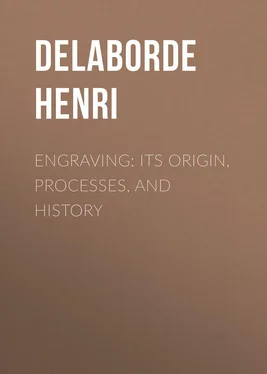Henri Delaborde - Engraving - Its Origin, Processes, and History
Здесь есть возможность читать онлайн «Henri Delaborde - Engraving - Its Origin, Processes, and History» — ознакомительный отрывок электронной книги совершенно бесплатно, а после прочтения отрывка купить полную версию. В некоторых случаях можно слушать аудио, скачать через торрент в формате fb2 и присутствует краткое содержание. Жанр: foreign_antique, foreign_prose, на английском языке. Описание произведения, (предисловие) а так же отзывы посетителей доступны на портале библиотеки ЛибКат.
- Название:Engraving: Its Origin, Processes, and History
- Автор:
- Жанр:
- Год:неизвестен
- ISBN:нет данных
- Рейтинг книги:5 / 5. Голосов: 1
-
Избранное:Добавить в избранное
- Отзывы:
-
Ваша оценка:
- 100
- 1
- 2
- 3
- 4
- 5
Engraving: Its Origin, Processes, and History: краткое содержание, описание и аннотация
Предлагаем к чтению аннотацию, описание, краткое содержание или предисловие (зависит от того, что написал сам автор книги «Engraving: Its Origin, Processes, and History»). Если вы не нашли необходимую информацию о книге — напишите в комментариях, мы постараемся отыскать её.
Engraving: Its Origin, Processes, and History — читать онлайн ознакомительный отрывок
Ниже представлен текст книги, разбитый по страницам. Система сохранения места последней прочитанной страницы, позволяет с удобством читать онлайн бесплатно книгу «Engraving: Its Origin, Processes, and History», без необходимости каждый раз заново искать на чём Вы остановились. Поставьте закладку, и сможете в любой момент перейти на страницу, на которой закончили чтение.
Интервал:
Закладка:
comte Henri Delaborde
Engraving: Its Origin, Processes, and History
EDITORIAL NOTE
The author of "La Gravure," of which work the present volume is a translation, has devoted so little attention to English Engraving, that it has been thought advisable to supplement his somewhat inadequate remarks by a special chapter dealing with this subject.
In accordance with this view, Mr. William Walker has contributed an account of the rise and progress of the British School of Engraving, which, together with his Chronological Table of the better-known English Engravers, will, we feel sure, add much to the value of the Work in the eyes of English readers.
CHAPTER I.
THE PROCESSES OF EARLY ENGRAVING. THE BEGINNINGS OF ENGRAVING IN RELIEF. XYLOGRAPHY AND PRINTING WITH MOVABLE TYPE
The nations of antiquity understood and practised engraving, that is to say, the art of representing things by incised outlines on metal, stone, or any other rigid substance. Setting aside even those relics of antiquity in bone or flint which still retain traces of figures drawn with a sharp-pointed tool, there may yet be found in the Bible and in Homer accounts of several works executed by the aid of similar methods; and the characters outlined on the precious stones adorning the breastplate of the high-priest Aaron, or the scenes represented on the armour of Achilles, might be quoted amongst the most ancient examples of the art of engraving. The Egyptians, Greeks, and Etruscans have left us specimens of goldsmith's work and fragments of all kinds, which, at any rate, attest the practice of engraving in their countries. Finally, every one is aware that metal seals and dies of engraved stone were in common use amongst the Romans.
Engraving, therefore, in the strict sense of the word, is no invention due to modern civilisation. But many centuries elapsed before man acquired the art of multiplying printed copies from a single original, to which art the name of engraving has been extended, so that nowadays the word signifies the operation of producing a print.
Of engraving thus understood there are two important processes or methods. By the one, strokes are drawn on a flat surface, and afterwards laboriously converted by the engraver into ridges, which, when coated with ink, are printed on the paper in virtue of their projection. By the other, outlines, shadows, and half-tints are represented by incisions intended to contain the colouring matter; while those parts meant to come out white on paper are left untouched. Wood-cutting, or engraving in relief, is an example of the first method; while to the second belongs metal-work or copperplate engraving, which we now call engraving with the burin, or line engraving.
In order to engrave in relief, a block, not less than an inch thick, of hard, smooth wood, such as box or pear, is used. On this block every detail of the design to be engraved is drawn with pen or pencil. Then such places as are meant to come out white in the print are cut away with a sharp tool. Thus, only those places that have been covered beforehand by the pencil or the pen remain at the level of the surface of the block; they only will be inked by the action of the roller; and when the block is subjected to the action of the press, they only will transfer the printing ink to the proof.
This method, earlier than that of the incised line, led to engraving "in camaïeu," which was skilfully practised in Italy and Germany during the sixteenth century. As in camaïeu engraving those lines which define the contours are left as ridges by the cutting away of the surrounding surface, we may say that in this method (which the Italians call "chiaroscuro") the usual processes of engraving in relief are employed. But it is a further object of camaïeu to produce on the paper flat tints of various depths: that is to say, a scale of tones somewhat similar to the effect of drawings washed in with Indian ink or sepia, and touched up with white. Now such a chromatic progression can only be arrived at by the co-operation of distinct processes. Therefore, instead of printing from a single surface, separate blocks are employed for the outlines, shadows, and lights, and a proof is taken by the successive application of the paper to all these blocks, which are made to correspond exactly by means of guiding marks.
A third style of engraving in relief, the "early dot manner," was practised for some time during the period of the Incunabuli, when the art was, as the root of this Latin word shows, still "in its cradle." By this method the work was no longer carried out on wood, but on metal; and the engraver, instead of completely hollowing out those parts destined to print light, merely pitted them with minute holes, leaving their bulk in relief. He was content that these masses should appear upon the paper black relieved only by the sprinkling of white dots resulting from the hollows.
We just mention by way of note the process which produced those rare specimens called " empreintes en pâte ." All specimens of this work are anterior in date to the sixteenth century, and belong less strictly to art than to industry, as the process only consisted in producing on paper embossed designs strongly suggesting the appearance of ornaments in embroidery or tapestry. To produce these inevitably coarse figures a sort of half-liquid, blackish gum or paste was introduced into the hollow portions of the block before printing. On the block thus prepared was placed a sheet of paper, previously stained orange, red, or light yellow, and the paste contained in the hollow places, when lodged on the paper, became a kind of drawing in relief, something like an impasto of dark colour. This was sometimes powdered with a fluffy or metallic dust before the paste had time to harden.
Though simple enough as regards the mere process, in practice line engraving demands a peculiar dexterity. When the outlines of the drawing that is to be copied have been traced and transferred to a plate usually made of copper 1 1 At the present day line engravers sometimes work on steel plates, as they are capable of supplying without damage a much greater number of proofs than can be printed from copper plates. It more frequently happens that a copper plate is coated with steel before being submitted to the action of the press, in order to preserve it, and to increase the number of copies without taking off the edge of the workmanship. That is to say, that by means of "electrotyping" a thin coat of metal is superimposed, which, since it considerably increases the power of endurance, increases the productiveness of the plate and the number of proofs that can be taken.
the metal is attacked with a sharp tool, called the dry-point. Then the trenches thus marked out are deepened, or fresh ones are made with the graver, which, owing to its shape, produces an angular incision. The appearance of every object represented in the original must be reproduced solely by these incised lines: at different distances apart, or tending in various directions: or by dots and cross-hatchings.
Line engraving possesses no other resources. Moreover, in addition to the difficulties resulting from the use of a refractory tool, we must mention the unavoidable slowness of the work, and the frequent impossibility of correcting faults without having recourse to such drastic remedies as obtaining a fresh surface by re-levelling the plate where the mistakes have been made.
Etching by means of aquafortis, originally used by armourers in their damascene work, is said to have been first applied to the execution of plates in Germany towards the close of the fifteenth century. Since then it has attracted a great many draughtsmen and painters, as it requires only a short apprenticeship, and is the quickest kind of engraving. Line engravers have not only frequently used etching in beginning their plates, but have often employed it, not merely to sketch in their subject, but actually in conjunction with the burin. Many important works owe their existence to the mixture of the two processes, among others the fine portraits of Jean Morin, and the admirable "Batailles d'Alexandre," engraved by Gérard Audran, after Lebrun. But at present we are only occupied with etching as practised separately and within the limits of its own resources.
Читать дальшеИнтервал:
Закладка:
Похожие книги на «Engraving: Its Origin, Processes, and History»
Представляем Вашему вниманию похожие книги на «Engraving: Its Origin, Processes, and History» списком для выбора. Мы отобрали схожую по названию и смыслу литературу в надежде предоставить читателям больше вариантов отыскать новые, интересные, ещё непрочитанные произведения.
Обсуждение, отзывы о книге «Engraving: Its Origin, Processes, and History» и просто собственные мнения читателей. Оставьте ваши комментарии, напишите, что Вы думаете о произведении, его смысле или главных героях. Укажите что конкретно понравилось, а что нет, и почему Вы так считаете.












